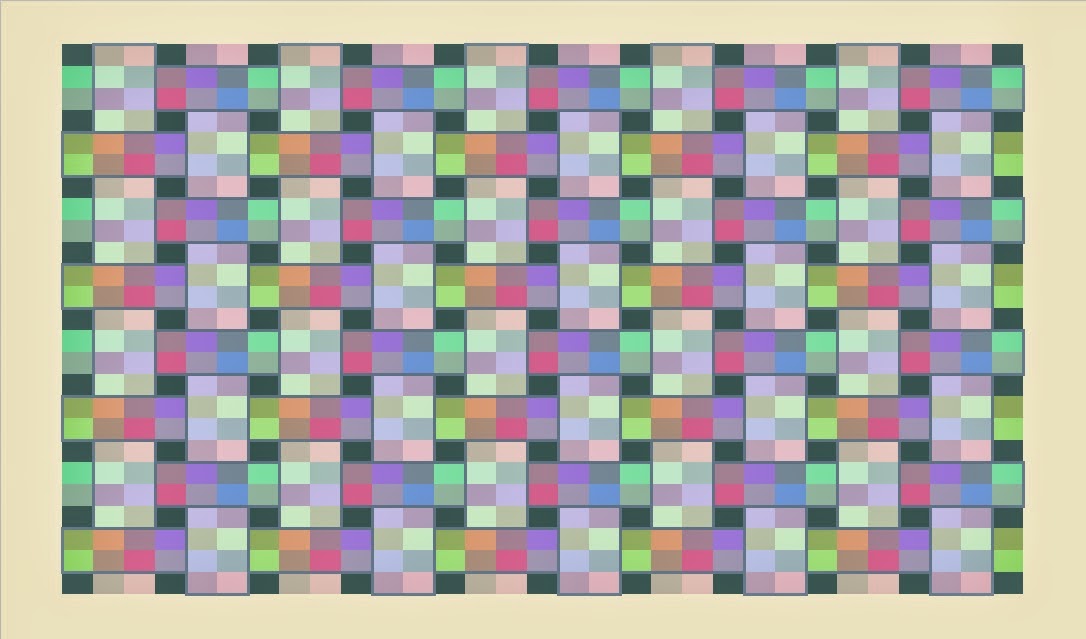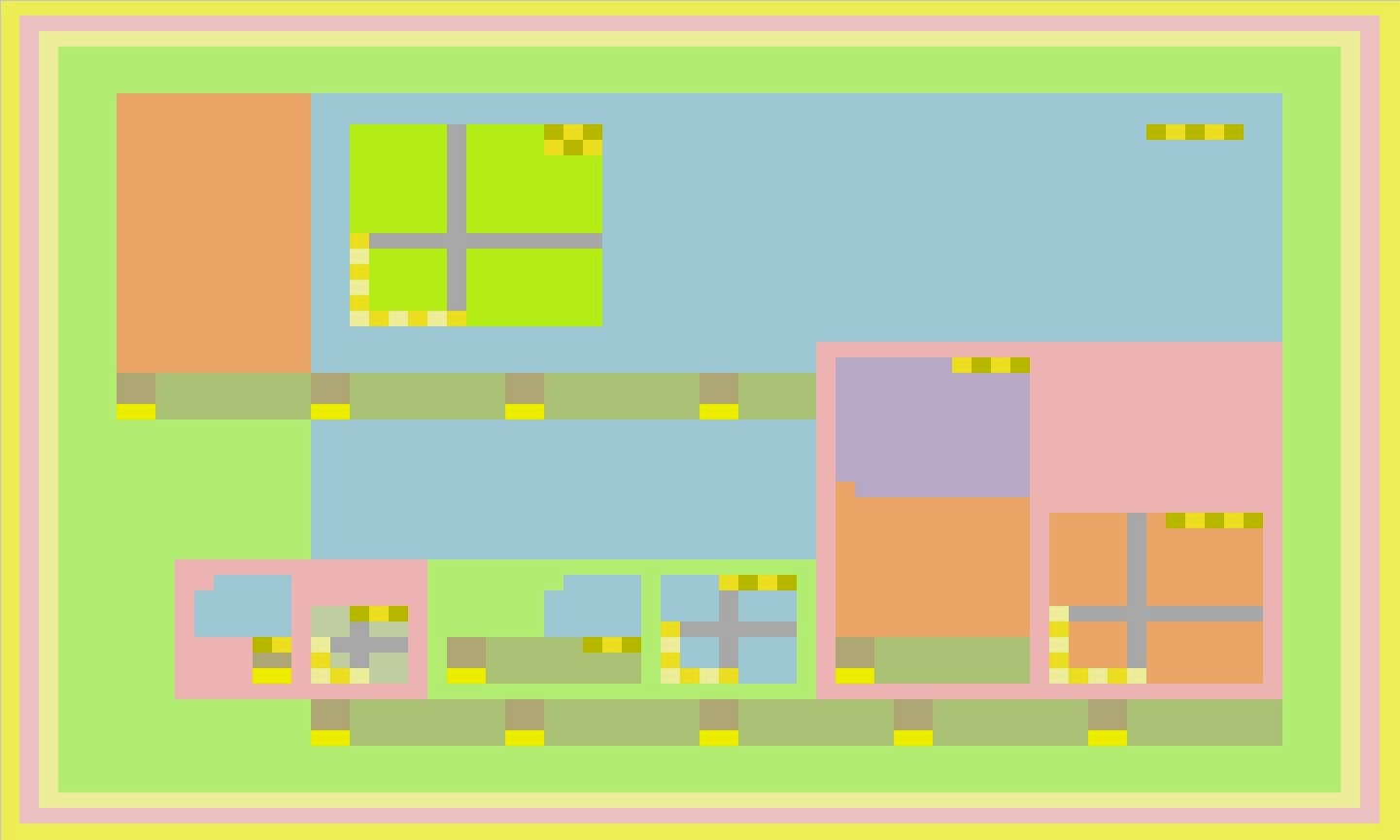Weaver birds, also known as weaver finches, get their name because of their elaborately woven nests
(the most elaborate of any birds'), though some are notable for their selective parasitic nesting habits. The nests vary in size, shape, material used, and construction techniques from species to species.
(Source: Wikipedia)
Yay, for all the wonderful bird life in nature !
patterns, types, type shifting patterns, composite patterns, globular patterns, large pixel art, colour rectangles, coloured square diagrams, short prose, poetry, abstract art, free thinking, inventor, original, number theory, tiling patterns, four regions of natural numbers, fuzzy thinking, Zen, yin yang philosophy, math art
Thursday 31 July 2014
Wednesday 30 July 2014
Saturday 26 July 2014
Wednesday 23 July 2014
Monday 21 July 2014
transport Egyptian fractions { keep on truckin' }
5/12 = 1/4 + 1/10 + 1/15 = 1/5 + 1/6 + 1/20
Lcm( 12, 4, 10, 15, 5, 6, 20 ) = 6025/60 = 15/60 + 6/60 + 4/60 = 12/60 + 10/60 + 3/60
60 is the smallest number with 6 representations as a sum of 2 primes:
60 = 7+53 = 13+47 = 17+43 = 19+41 = 23+37 = 29+31
Sunday 20 July 2014
Friday 18 July 2014
Thursday 17 July 2014
The dynamics of positive integers with regards to happy numbers
A happy number example
A number such as 334 is three hundred and thirty four with digits forming the multiset { 3, 3, 4 }
We then sum the squares of these digits: 3^2 + 3^2 + 4^2 = 9 + 9 + 16 = 34
Now we do the same for 34: 3^2 + 4^2 = 9 + 16 = 25
And iterating this process:
2^2 + 5^2 = 4 + 25 = 29
2^2 + 9^2 = 4 + 81 = 85
8^2 + 5^2 = 64 + 25 = 89
8^2 + 9^2 = 64 + 81 = 145
1^2 + 4^2 + 5^2 = 1 + 16 + 25 = 42
4^2 + 2^2 = 16 + 4 = 20
2^2 + 0^2 = 4 + 0 = 4
If we keep going there is a cycle:
4^2 = 16 ; 1^2 + 6^2 = 37 ; 3^2 + 7^2 = 58 ; 5^2 + 8^2 = 89 ; and then 145, 42, 20, 4, as before.
If the number enters into the cycle 4, 16, 37, 58, 89, 145, 42, 20, 4 the number is called “happy”.
The only other cycle is 1, 1, 1, 1, …
An interesting question is: how do happy numbers “enter into” the cycle ?
For example, with 334, the number enters into the cycle at 89.
This visualisation shows the dynamics of this process for numbers 1 up to 40 using distinctive colours for the digit values 0, 1, 2, …, 9 and box borders to show where the number enters into a cycle.
We then sum the squares of these digits: 3^2 + 3^2 + 4^2 = 9 + 9 + 16 = 34
Now we do the same for 34: 3^2 + 4^2 = 9 + 16 = 25
And iterating this process:
2^2 + 5^2 = 4 + 25 = 29
2^2 + 9^2 = 4 + 81 = 85
8^2 + 5^2 = 64 + 25 = 89
8^2 + 9^2 = 64 + 81 = 145
1^2 + 4^2 + 5^2 = 1 + 16 + 25 = 42
4^2 + 2^2 = 16 + 4 = 20
2^2 + 0^2 = 4 + 0 = 4
If we keep going there is a cycle:
4^2 = 16 ; 1^2 + 6^2 = 37 ; 3^2 + 7^2 = 58 ; 5^2 + 8^2 = 89 ; and then 145, 42, 20, 4, as before.
If the number enters into the cycle 4, 16, 37, 58, 89, 145, 42, 20, 4 the number is called “happy”.
The only other cycle is 1, 1, 1, 1, …
An interesting question is: how do happy numbers “enter into” the cycle ?
For example, with 334, the number enters into the cycle at 89.
This visualisation shows the dynamics of this process for numbers 1 up to 40 using distinctive colours for the digit values 0, 1, 2, …, 9 and box borders to show where the number enters into a cycle.
what's something unusual about the numbers 45 and 2025 ?
number 45 is special ~ a Kaprekar number !
The first few are 1, 9, 45, 55, 99, 297, 703, ... (Sloane's A006886).
45^2 = 2025 and 20 + 25 = 45
2025 = ( 20 + 25 ) * 45
the visualisation below shows the 2025 small unit squares
in two different ways
as a 5*9 arrangement of components
each having 9*5 unit square dimensions
each having 9*5 unit square dimensions
or a 9*5 arrangement of components
each having 5*9 unit square dimensions
each having 5*9 unit square dimensions
odd~one~out
Wednesday 16 July 2014
Sunday 13 July 2014
Saturday 12 July 2014
Tuesday 8 July 2014
Saturday 5 July 2014
Subscribe to:
Posts (Atom)

























